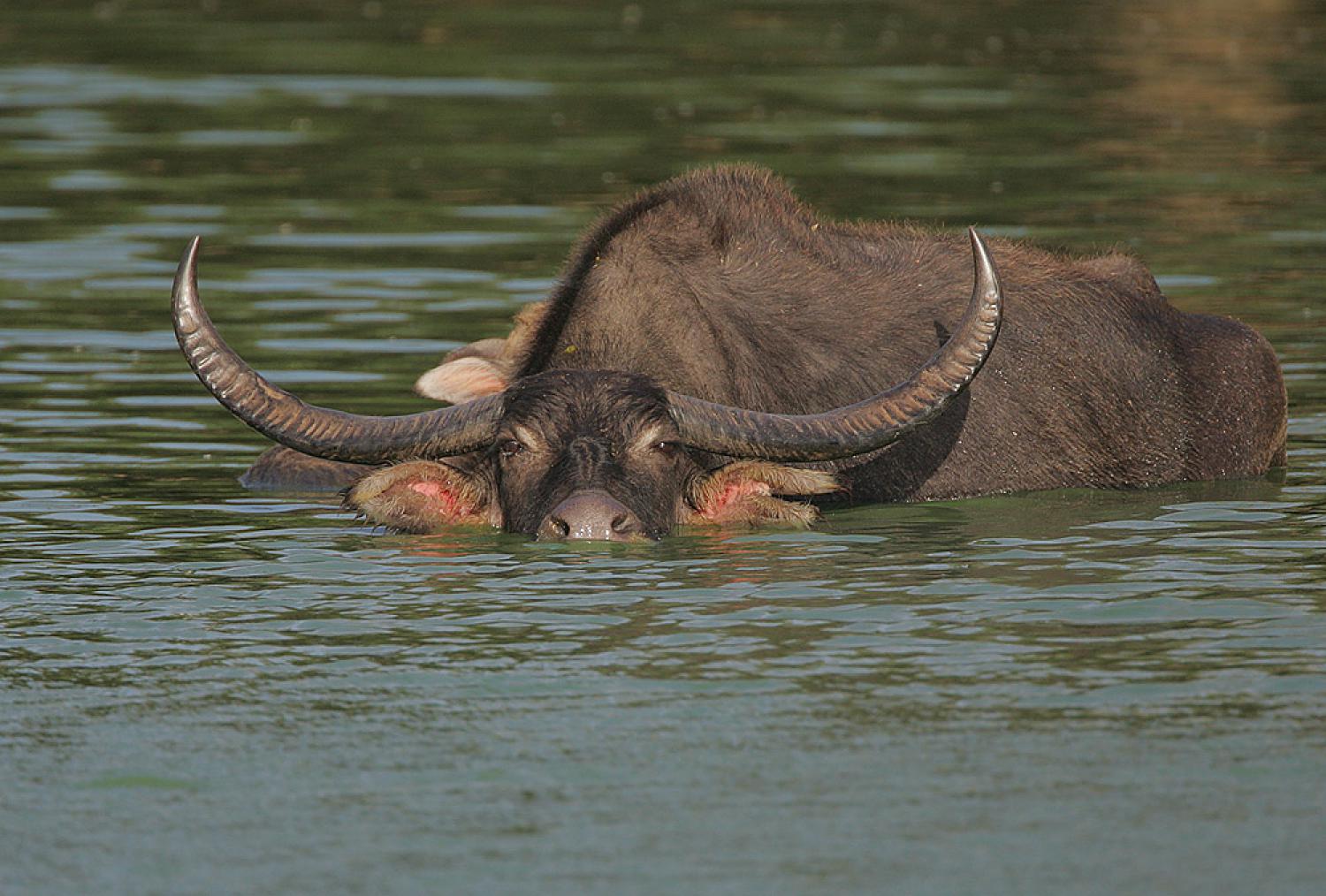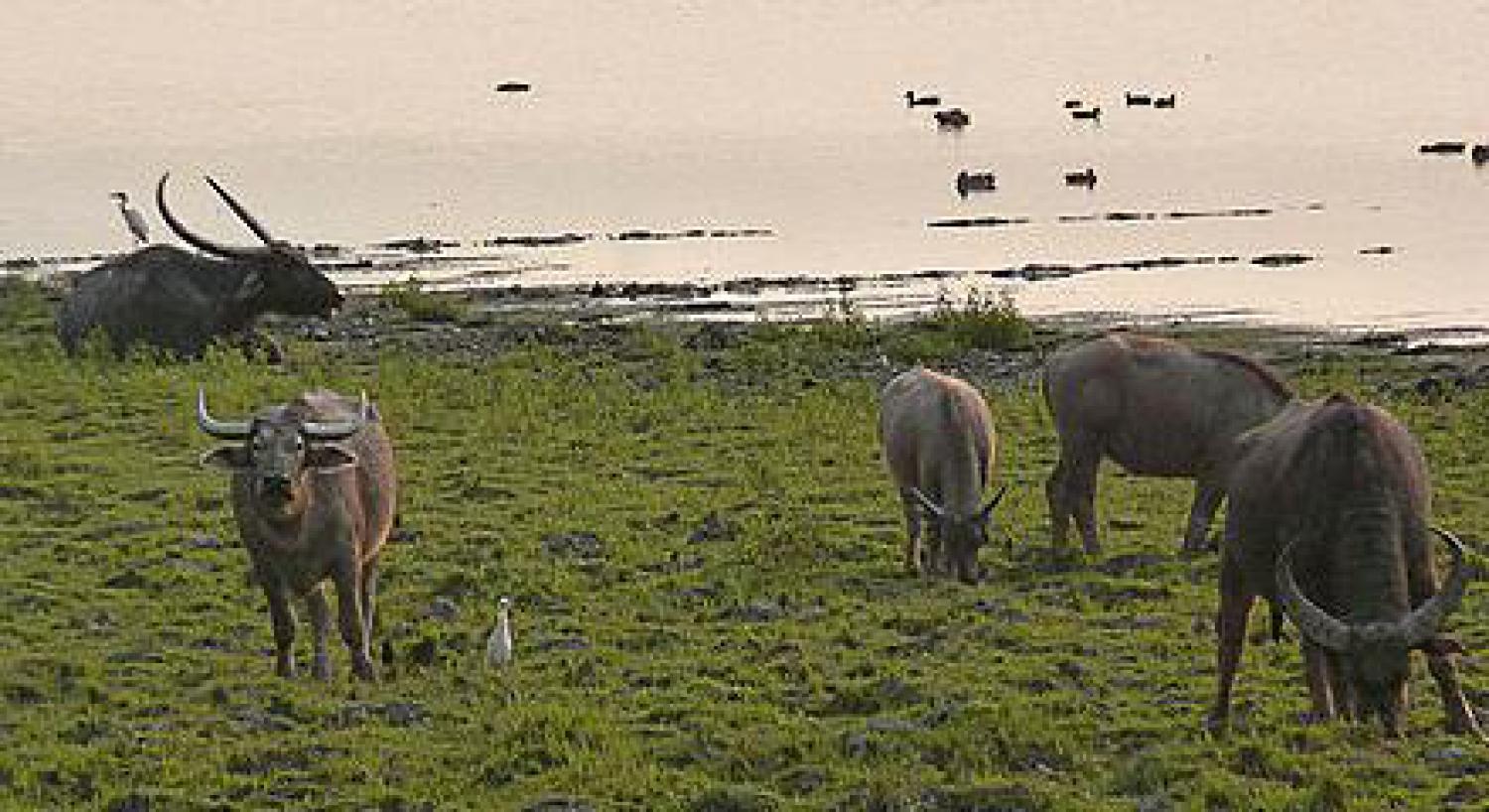Species of Thailand
Wild water buffalo
Bubalus arnee
Robert Kerr, 1792
In Thai: ควายป่า
The wild water buffalo (Bubalus arnee), also called Asian buffalo and Asiatic buffalo, is a large bovine native to the Indian Subcontinent and Southeast Asia. It is listed as Endangered in the IUCN Red List since 1986, as the remaining population totals less than 4, 000, with an estimate of fewer than 2, 500 mature individuals. The population decline of at least 50% over the last three generations (24–30 years) is projected to continue. The global population has been estimated at 3, 400 individuals, of which 3, 100 (91%) live in India, mostly in Assam. The wild water buffalo represents most likely the ancestor of the domestic water buffalo.
Characteristics
Wild water buffalo are larger and heavier than domestic buffalo, and weigh from 700 to 1200 kg. Their head-to-body-length is 240 to 300 cm with a tail 60 to 100 cm long, and a shoulder height of 150 to 190 cm. Both sexes carry horns that are heavy at the base and widely spreading up to 2 m along the outer edges, exceeding in size the horns of any other living bovid. Their skin color is ash gray to black. The moderately long, coarse and sparse hair is directed forward from the haunches to the long and narrow head. There is a tuft on the forehead, and the ears are comparatively small. The tip of the tail is bushy; the hooves are large and splayed.
They rank alongside the gaur as the heaviest living wild bovid species, as both attain similar average if not maximum weights, although, with their stockier, shorter-legged frame, wild water buffalo are somewhat less in length and height than the gaur.
Distribution and habitat
Wild water buffalos occur in India, Nepal, Bhutan, Thailand, and Cambodia, with an unconfirmed population in Myanmar. They have been extirpated in Pakistan, Bangladesh, Laos, and Vietnam. They are associated with wet grasslands, swamps and densely vegetated river valleys.
In India, they are largely restricted to in and around Kaziranga, Manas and Dibru-Saikhowa National Parks, Laokhowa Wildlife Sanctuary and Bura Chapori Wildlife Sanctuary and in a few scattered pockets in Assam; and in and around D'Ering Memorial Wildlife Sanctuary in Arunachal Pradesh. A small population survives in Balpakram National Park in Meghalaya, and in Chhattisgarh (formerly part of Madhya Pradesh) in the Indravati National Park and the Udanti Wildlife Sanctuary. This population might extend into adjacent parts of Orissa. In the early 1990s, there may still have been about 3, 300–3, 500 wild buffaloes in Assam and the adjacent states of northeast India. In 1997, the number was assessed at less than 1, 500 mature individuals.
Many surviving populations are believed to have interbred with feral or domestic water buffalos. In the late 1980s, fewer than 100 wild buffaloes were left in Madhya Pradesh. By 1992, only 50 animals were estimated to have survived there.
Nepal's only population lives in the Koshi Tappu Wildlife Reserve, and has grown from 63 individuals in 1976 to 219 individuals in 2009. The are two large herds comprising 87 and 99 animals, and two smaller herds of subadult males and some isolated single males. This small population is seriously threatened.
In and around Bhutan's Royal Manas National Park, a small number of wild water buffaloes occur. This is part of the subpopulation that occurs in India's Manas National Park. In Myanmar, a few wild-living animals independent of human husbandry live in the Hukaung Valley Tiger Reserve.
In Thailand, wild buffaloes have been reported to occur in small herds of less than 40 individuals. A population of 25–60 individuals inhabited lowland areas of the Huai Kha Khaeng Wildlife Sanctuary between December 1999 and April 2001. This population has not grown significantly in 15 years, and may be interbreeding with domestic water buffalo.
The population in Cambodia is confined to a small area of easternmost Mondulkiri and possibly Ratanakiri Provinces. Only a few dozen individuals remain.
The origin and genetic status of the so-called wild buffalos in Sri Lanka is unclear. There is cross-breeding with domestic stock and it is believed to be unlikely that there are true wild buffalos left on the island. Wild living populations found elsewhere in Asia are feral. Water buffaloes were introduced to northern Australia, Argentina and Bolivia, where they became feral.
Ecology and behavior
Wild water buffalos are both diurnal and nocturnal. Adult females and their young form stable clans of as many as 30 individuals that have home ranges of 170 to 1000 ha, including areas for resting, grazing, wallowing and drinking. Clans are led by old cows, even when bulls accompany the group. Several clans form a herd of 30 to 500 animals that gather at resting areas. Adult males form bachelor groups of up to 10 individuals, with older males often solitary, and spend the dry season apart from the female clans. They are seasonal breeders in most of their range, typically in October and November. However, some populations breed year round. Dominant males mate with the females of a clan who subsequently drive them off. Their gestation period lasts 10 to 11 months, with an interbirth interval of one year. They typically give birth to a single offspring, although twins are possible. Age at sexual maturity is 18 months for males, and three years for females. The maximum known lifespan is 25 years in the wild. In the wild in Assam, the herd size varied from three to 30 individuals.
They are probably grazers by preference, feeding mainly on true grasses when available, such as scutch grass, and sedges, but they also eat herbs, fruits, and bark, as well as browsing on trees and shrubs. They also feed on crops, including rice, sugarcane, and jute, sometimes causing considerable damage.
Threats
A population reduction by at least 50% over the last three generations seems likely given the severity of the threats, especially hybridization; this population trend is projected to continue into the future. The most important threats are:
- interbreeding with feral and domestic buffalo in and around protected areas;
- hunting, especially in Thailand, Cambodia, and Myanmar;
- habitat loss of floodplain areas due to conversion to agriculture and hydropower development;
- degradation of wetlands due to invasive species such as stem twiners and lianas;
- diseases and parasites transmitted by domestic livestock;
- interspecific competition for food and water between wild buffalo and domestic stock.
Tigers prey on adult wild water buffalo, and Asian black bears have also been known to kill them.
Conservation
Bubalus arnee is included in CITES Appendix III, and is legally protected in Bhutan, India, Nepal, and Thailand.
Taxonomic history
Carl Linnaeus applied the binomial Bos bubalis to the domestic water buffalo in his first description of 1758. In 1792, Robert Kerr applied the binomial Bos arnee to the wild species occurring in India north from Bengal. Later authors subordinated the wild water buffalo under either Bos, Bubalus or Buffelus.
In 2003, the International Commission on Zoological Nomenclature placed Bubalus arnee on the Official List of Specific Names in Zoology, recognizing the validity of this name for a wild species. Most authors have adopted the binomen Bubalus arnee for the wild water buffalo as valid for the taxon.
Only few DNA sequences are available from wild water buffalo populations. Wild populations are considered to be the progenitor of modern domesticated water buffalo, but the genetic variation within B. arnee is unclear, and also how they are related to the domesticated river and swamp forms.
This article uses material from Wikipedia released under the Creative Commons Attribution-Share-Alike Licence 3.0. Eventual photos shown in this page may or may not be from Wikipedia, please see the license details for photos in photo by-lines.
Scientific classification
- Kingdom
- Animalia
- Phylum
- Chordata
- Class
- Mammalia
- Order
- Artiodactyla
- Family
- Bovidae
- Genus
- Bubalus
- Species
- Bubalus arnee
Common names
- German: Wasserbüffel
- English:
- Asian buffalo
- Asiatic buffalo
- Indian buffalo
- Indian water buffalo
- Water buffalo
- Wild Asian buffalo
- Wild water buffalo
- Spanish:
- Bufalo arni
- Búfalo de agua salvaje
- Búfalo silvestre
- French:
- Buffle d'eau
- Buffle de L'Inde
- Italian:
- Bufalo indiano
- Bufalo d'acqua
- Russian:
- Азиатский буйвол
- индийский буйвол
- индийский водяной буйвол
- арни
- Swedish: Vattenbuffel
- Thai: ควายป่า
Synonyms
- Bubalis bubalis migona, Paul E. Pieris Deraniyagala (1953)
- Bubalus bubalus septentrionalis, Paul Matschie (1912)
- Bos bubalus var. fulvus, William Thomas Blanford (1891)
- Bubalus arna var. macrocerus, Brian Houghton Hodgson (1842)
- Bubalus arna, Brian Houghton Hodgson (1841)
- Bos arni, Hamilton Smith (1827)
Conservation status

Endangered (IUCN3.1)
Photos
Please help us review our species pages if wrong photos are used or any other details in the page is wrong. We can be reached via our contact us page.
Range Map

- Huai Kha Khaeng Wildlife Sanctuary

